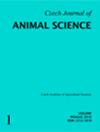A comparative study on the effect of quantitative feed restriction in males and females of broiler chickens, rabbits and nutrias. I. Performance and carcass composition
IF 1.4
4区 农林科学
Q3 AGRICULTURE, DAIRY & ANIMAL SCIENCE
引用次数: 6
Abstract
The aim of the study was to compare the effects of feed restriction on the growth performance and carcass composition of chicken, rabbit and nutria males and females. Feed restriction was applied at a rate of 70% ad libitum from 14 to 21 days of age in chickens, 70% ad libitum from 42 to 49 days of age in rabbits, and 70% ad libitum from 12 to 15 weeks of age in nutrias. Animals were fed ad libitum prior to and following restriction. Carcass composition was evaluated at common slaughter ages, i.e., 31 days in chickens, 70 days in rabbits, and eight months in nutrias. The results showed stronger effects of feed restriction, sex, and their interaction in broiler chickens than in rabbits and nutrias. In chickens, feed restriction increased the sex differences in final body weight, which were associated with interaction of feed restriction and sex (P = 0.009). Feed restriction as a fixed factor significantly affected growth and feed conversion in chickens and it was with no effect in rabbits and nutrias. The effect of feed restriction on carcass composition was negligible in all selected species. With respect to sex, significant differences were observed in chickens in final body weight, daily weight gain, dressing out percentage and breast percentage, in rabbits in loin percentage, and in nutrias in growth and perirenal fat percentage. Results of the study indicated that interactions of feed restriction and sex in growth might be associated with a short realimentation period.定量限饲对肉鸡、家兔和营养动物雌雄影响的比较研究。1 .性能和胴体组成
本研究的目的是比较饲料限制对鸡、兔和海狸鼠雄性和雌性生长性能和胴体组成的影响。鸡在14至21日龄时以70%的自由采食量限制,兔在42至49日龄时按70%的自由产食量限制,营养素在12至15周龄时按70的自由产气量限制。在限制之前和之后随意喂养动物。在常见屠宰年龄,即鸡31天、兔70天和海狸鼠8个月,评估胴体组成。结果表明,肉鸡在限饲、性别及其相互作用方面的效果强于家兔和营养素。在鸡中,饲料限制增加了最终体重的性别差异,这与饲料限制和性别的相互作用有关(P=0.009)。在所有选定物种中,饲料限制对胴体组成的影响可以忽略不计。就性别而言,鸡的最终体重、日增重、屠宰率和胸脯率、兔的腰肉率、生长中的营养素和肾周脂肪率存在显著差异。研究结果表明,生长期短可能与限制进食和性别的相互作用有关。
本文章由计算机程序翻译,如有差异,请以英文原文为准。
求助全文
约1分钟内获得全文
求助全文
来源期刊

Czech Journal of Animal Science
Agriculture, Dairy & Animal Science-奶制品与动物科学
CiteScore
2.40
自引率
16.70%
发文量
44
审稿时长
5 months
期刊介绍:
Original scientific papers and critical reviews covering all areas of genetics and breeding, physiology, reproduction, nutrition and feeds, technology, ethology and economics of cattle, pig, sheep, goat, poultry, fish and other farm animal management. Papers are published in English.
 求助内容:
求助内容: 应助结果提醒方式:
应助结果提醒方式:


